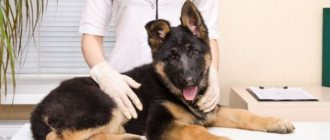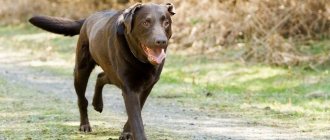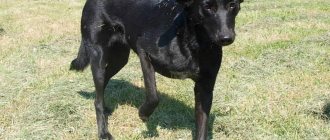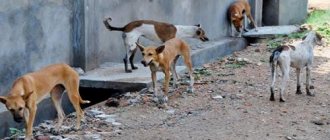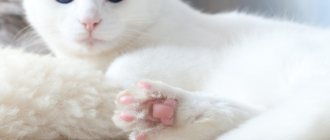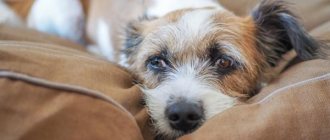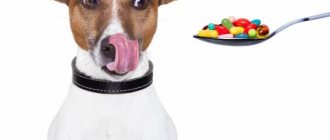Breeders often have to deal with a situation where an active dog suddenly begins to limp, tucks his front paw, or licks it. This behavior usually indicates that the quadruped has injured a limb. In rare cases, an animal, keen on running and active games, may not notice the injury for some time, then the owner will learn about what happened from traces of blood on the snow or asphalt.
The dog owner must understand that a large pet, stepping on glass, will receive a deeper cut than a miniature one.
So, the dog has cut the pad on its paw - what to do in this difficult situation?
On average, the wound healing period ranges from 1 to 3 weeks
First aid for cut paws
If your dog cuts its paw, you need to remain calm. It is important to conduct a thorough examination of the limb. You don’t have to go to a medical facility if the wound is very small and not deep. In order to help an animal yourself, you need to know the basics of providing medical care.
First of all, you need to provide full access to the cut. To do this, you need to remove the hair from the injured area using scissors. It is especially important to “open” the wound in a long-haired pet. Hair that has not been cut can provoke an inflammatory process. Next, the injury site should be washed thoroughly. To do this, use running water. The cut area should not contain any particles of dirt, hair or other debris. It is strictly forbidden to use cotton wool or cotton pads to stop bleeding: fluffy fibers can cause suppuration.
How to treat a cut on a dog's pad
After cleaning the wound, you must use an antiseptic solution. Suitable for these purposes:
- A weak solution of manganese.
- Chlorhexidine.
- Hydrogen peroxide.
- Furacilin solution.
Attention! To make wound treatment easier, you can purchase a disposable syringe at the pharmacy.
To get rid of swelling, the areas around the cut should be smeared with brilliant green or iodine. It is strictly prohibited to pour alcohol-containing solutions into wounds; they can cause burns to muscle tissue. Neglecting this recommendation will worsen the problem and delay recovery.
Then you need to wrap a piece of gauze bandage treated with antiseptic ointment to the injured limb. These medications may be applied directly to the cut site. The dressing procedure should be done daily.
Taking protein-based medications will help speed up the healing process. Therapy is prescribed by the attending physician.
In order to help an animal with a small wound on the pillow, you can seal it with BF glue.
If a complication begins, the veterinarian will be able to diagnose and prescribe appropriate treatment.
SobakinoAbout dogs for people
Often dog breeders are faced with a situation where their beloved pets injure their paws while playing at home or walking. As a result of a cut on the paw, the wounded part begins to bleed and the dog limps.
It would seem that it is quite simple to cope with this injury by tightening the area over the wound with a tourniquet and treating it with brilliant green. Providing such first aid is a very simple procedure, at the end of which you just need to bandage the wound. However, many, even when providing first aid, make trivial mistakes, due to which the veterinary clinic is the final point of rescuing the pet. If first aid attempts fail, many dog breeders even use their own urine to treat the wound. But, knowing basic things, you can avoid serious consequences and cure a paw cut quickly and painlessly.
It is important to remember that licking the injured area is strictly prohibited. When a dog begins to lick its wound, it can introduce a huge number of microbes into it, which can lead to severe inflammatory processes. Many people think that saliva has healing properties, but this is a deep misconception. When a dog licks its wound, it takes twice as long to heal. To prevent unwanted licking, you need to put a special collar-shaped muzzle on your pet's face.
The following rule may seem contrary to the norms when providing first aid - you should not apply a tourniquet over the wound. Few people know how to do it correctly. Dog breeders often apply a tourniquet, tightening the veins, which leads to the opposite effect - the wound bleeds more than before. Instead of a tourniquet, it is better to wrap the wound with a special bandage that can stop the bleeding within fifteen minutes.
Do not pour powder on the wound. Many veterinarians recommend using powdered streptocide when treating open wounds, but modern medicine still advises avoiding the use of such products. The powder can burn muscle tissue, especially if the wound is very deep. Tissue damage leads to the formation of pustules, which aggravates the condition of the wound.
After damaging the paw, the first thing you need to do is wash the wound with an antiseptic solution; it is recommended to use a weak solution of hydrogen peroxide or potassium permanganate. You can wash the damaged area with boiled water without adding antiseptic powder. Before washing, you need to remove dirt and hair from the wound. The area on the skin in front of the wound must be free of hair to prevent it from getting into the injured cavity. If this is not done, the inflammatory process can develop much faster.
After providing the correct first aid, be sure to visit an experienced veterinarian. Only a specialist can assess the severity of the wound and prescribe the correct treatment. No matter how strange it may sound, a wide wound is not as dangerous as a narrow and deep one. A foreign body can get into a narrow wound, but it will not be noticeable. Often, an invisible foreign body can only be removed surgically. An experienced veterinarian can detect deformation of the tendons and ligaments; if the tendons are torn, the doctor carefully stitches them up. When the veterinarian applies sutures to the tendons, the pet owner must fix the paw in such a way that the sutures do not come apart and the tendons heal correctly.
So, when cutting your paw, you need to remember the following things:
- If there is a deep cut and heavy bleeding, you should contact a veterinarian;
- It is better not to tighten the wound with a tourniquet, but to use a rigid bandage for dressing;
- it is necessary to immediately trim the hair around the wound;
- Do not under any circumstances wipe the wound with cotton wool or a cotton pad. Otherwise, small particles of cotton wool may get into the wound, which will lead to rapid suppuration;
- Washing the wound can be done with a solution of manganese, a weak solution of brilliant green, or a solution of hydrogen peroxide. You can wash the wound with a solution of furatsilin or chlorhexidine;
- after washing, you need to regularly apply dressings accompanied by ointments (usually Levosin or Levomekol are used);
- You should not let your dog lick your wound;
- Be sure to avoid getting iodine or brilliant green into the wound, they can burn muscle tissue.
How to walk a dog if its paw is injured? You need to put a sock on the injured limb and secure it with an adhesive plaster. If the weather is humid outside, before walking you need to put a plastic bag on your paw, and then a sock, which will be carefully secured with an adhesive plaster. During each walk, you need to watch your dog so that it does not step on a sharp stone or splinter. At home, you should not let her play with piercing or cutting objects.
What to do if the bleeding doesn't stop
If the cut exceeds 2 cm in length or depth, and the bleeding cannot be stopped, then you cannot do without a veterinarian. You should apply a tight bandage and go to a medical facility, where a specialist will stitch the wound. Otherwise, the injury will take a very long time to heal, after which a scar will appear that will interfere with the dog’s movement.
If the cut is not deep, stitches will be placed under local anesthesia. A stitched wound will heal much faster and the animal will soon begin to walk normally.
What not to do if your dog cuts his paw pad
There is no need to apply a tourniquet without proper experience. To perform the procedure correctly, you must have certain skills. An ineptly applied tourniquet will only increase bleeding, while a regular gauze bandage will stop the bleeding within 20 minutes.
You should refuse treatment with urine, and also refrain from treating the wound with powder products. The well-known crystalline drug with antibacterial action can cause a burn of muscle tissue. It is possible that the owner’s carelessness will result in the formation of purulent wounds and worsen the animal’s condition.
Contrary to popular belief, you should not allow your dog to lick a cut.
Attention! The healing ability of saliva is noticeably exaggerated!
The oral cavity contains a high concentration of bacteria and microorganisms. This type of therapy will not alleviate the dog's suffering. The dog will not be able to reach the wound if you put a special collar on his neck. It is important to ensure careful monitoring of the four-legged animal during this period.
A special collar will prevent the dog from bothering the wound
How to apply a bandage so your dog can't remove it
To prevent the dog from removing the bandages, you need to put a baby sock on the injured limb. Additional fixation will be provided by simple tape. To do this, wrap adhesive tape over the dressing material at the narrowest point. If you need to repeat the treatment of the wound, just cut the tape using office scissors.
Licking wounds is a natural behavior pattern for dogs, but in this case it is inappropriate
Prevention and elimination of purulent inflammation
After the bleeding has been stopped, it is necessary to prevent purulent complications. Through a cut, an infection can be introduced into the animal’s body (it’s not for nothing that an open wound is called a “gateway” for pathogens of infectious diseases). Injured skin is very susceptible to external factors and creates a high risk of developing pathogenic microflora. The use of potassium permanganate and hydrogen peroxide during antiseptic treatment, thanks to active oxygen, makes it possible to defeat anaerobic purulent bacteria. The bandage should be applied in such a way that the blood vessels on the animal’s paw are not compressed. At the site of bone articulation, the dressing material is secured on both sides.
If suppuration has already begun, it is advisable to cover the wound with sterile material and show the pet to a doctor.
In a situation where there is no opportunity to visit a medical facility, you will have to act independently. Sutures are not used on festering wounds. Great attention must be paid to cleansing the wound. This will be followed by applying ointment and a sterile bandage to the dog's paw. To prevent the dog from licking, you need to use special devices.
Attention! If the dog’s condition has worsened: the temperature has risen, convulsions have begun, the animal is lethargic and refuses to eat – there is no time to hesitate! The dog needs to be seen by a doctor, most likely he will need antibiotics!
The wound should be treated as soon as possible
Types of Fractures Occurring in Dogs
Fractures vary depending on what part of the animal's body is injured:
- fractures of tubular bones occur due to injury to the limbs;
- fractures of the pelvic (flat) bones;
- fractures of other bones (skull, jaw, tail, spine).
The signs of a fracture accompanying the injury depend on how badly the dog’s bone is damaged:
- A bone fracture is the mildest type of injury, in which the bone is not completely damaged and the surrounding tissues are not damaged. In this case, a broken paw in a dog can be confused with a bruise, since the animal is quite active, only limping slightly. But in the future, the damaged bone may not be able to withstand the increased load when jumping or running, and the crack can become a serious fracture. A crack cannot be diagnosed by eye, so if your pet is limping or does not allow itself to be touched in some places, you need to take an x-ray.
- An unsuccessful landing on the front legs when jumping from a height can result in an impaction fracture, in which parts of the bone fit into each other. In this case, the damaged bone can fix itself, and the symptoms of the fracture will be blurred and similar to those that accompany a bone crack - pain, limping. The danger is that the fracture may become more complicated if it is not diagnosed and treated, causing a simple injury to become more severe.
- A closed bone fracture without displacement - the bone is completely broken, but its ends at the fracture site are in a natural position. If a dog breaks its paw, there is swelling and severe pain at the site of injury, and the animal does not step on the limb. If the jaw is injured, he refuses to eat; if the spine is fractured, he cannot control his paws.
- Displaced closed fracture - In this case, the broken ends of the bone move apart and can damage the tissue next to the bone. The pain in this case is even more pronounced; severe swelling, bulge, and hematoma may appear at the fracture site, and in case of a vertebral fracture, the nerve endings may be pinched, which causes paralysis of the limbs.
- If the broken bone breaks through the skin, then it is an open fracture. This is the most dangerous option, since an open wound can become infected, which significantly complicates treatment, and bone fragments damage muscles, nerves, and blood vessels, which can result in bleeding.
In what cases should you contact a veterinarian?
Only a doctor can give an objective assessment of the animal’s condition if the dog has cut the pad on its paw. Even if the owner was able to stop the bleeding without difficulty, there is no point in refusing to have the wound examined by a specialist. The doctor will give his recommendations, tell you about the conditions of detention in the current situation, and tell you how to speed up recovery.
If the cut is too severe, a healthcare professional will need stitches. In practice, there have been many cases when it is impossible to clear the affected area of foreign bodies without surgical intervention.
In addition, a visit to the veterinary clinic is necessary if:
- Cut tissue between fingers.
- Damage to nails and joints.
- Tendon and ligament deformities.
Attention! The three problems listed above, if the dog has injured its paw, can lead to interdigital inflammation, skin rejection and complete limitation of motor activity.
First aid rules
Acting as a home doctor Aibolit, you must pursue two goals:
- minimize unpleasant moments for your pet;
- prevent possible complications.
The following recommendations will help you achieve them:
- Carefully inspect the injured paw. If you find a piece of glass, a wooden splinter or other foreign object with which the dog has cut the pad, remove it with tweezers.
- Take scissors and rid the injury site of hair (this primarily applies to long-haired pets). This will prevent hairs from getting into the skin that has peeled off from the cut and becoming infected.
- Rinse the dog's injured limb under running water, which will remove dirt, hair, and foreign bodies from the wound.
- If your dog has a deep cut on its paw, sterile gauze swabs will help stop the bleeding. In case of severe pulsating bleeding, you need to make a thick gauze or fabric roll and tie it tightly to the wound.
- Treat the damaged pad with a disinfectant (solution of furatsilin or potassium permanganate, chlorhexidine, hydrogen peroxide). For convenience, the antiseptic can be drawn into a syringe.
- Apply iodine or brilliant green to the edges of the wound - this will eliminate painful swelling. Make sure that the alcohol-containing substance does not get into the wound itself. This way you will avoid burns to internal tissues and long healing times.
- Apply an antimicrobial and anesthetic agent (Levomekol or Levosin) to a gauze napkin, apply to the damaged area and secure with a bandage. A thick sock will help securely fix the bandage. Take your pet outside by putting an umbrella cover, shoe cover or surgical bag over the injured paw over the bandage and sock. It can be secured with adhesive tape.
- Change the dressing every 24 hours, rinsing the wound with chlorhexine and reapplying a bandage with bactericidal ointment.
- A few days after the dog cuts its paw, add Solcoseryl or Actovegin ointment to the treatment process. Such products accelerate cellular metabolism and tissue repair.
How to walk with an animal and prevent cut paws
To prevent the occurrence of cuts, you should avoid walking in places where garbage may be scattered, you should avoid dirty streets and uncleaned lawns. You can often find broken glass or sharp objects on them. You must not let the animal out of sight, because the owner, while walking, is responsible for the well-being of his pet. It is best to go to a specialized site, even if it is not very close to home.
Unfortunately, it is impossible to predict everything, but every effort should be made to avoid injury. Every person should strive for cleanliness and pick up trash after a picnic; careless treatment of nature has a detrimental effect on the environment and causes trouble not only for people, but also for their pets.
It is better to walk with your pet in specially designated areas.
Common mistakes when treating cuts at home
The most common mistakes are:
- Inaction, in the hope that the dog will heal itself by licking the wound.
- Inept application of a tourniquet.
- Using alcohol-based products to treat cuts.
- The use of fibrous material to cleanse the wound.
A dog is man's best friend. And the breeder should definitely know what to do if the dog hurts its paw.
Any owner should definitely know what to do if a dog hurts its paw
A wound licked by an animal heals twice as slowly. To prevent the dog from tearing off the bandage and reaching the sore spot with his tongue, a collar is put on his neck.
When do you need veterinary help?
Even if your dog has slightly cut the pad on its paw and you know how to treat the wound, it won’t hurt to consult a veterinarian just in case. This needs to be done, if only because the doctor is able to more accurately assess the clinical picture. It happens that microscopic splinters, invisible to the naked eye, get into a deep narrow cut. Only surgery can get rid of them.
Emergency cases when a visit to the veterinarian is required:
- damage to interdigital tissues, manifested by a progressive inflammatory process;
- touching ligaments, tendons, joints with severe swelling;
- injury and deformation of the nail plate;
- inability to independently remove a piercing object from the wound;
- severe bleeding that does not stop for more than 15 minutes;
- swelling, suppuration or bleeding of the wound, which bothers you for several days.
The listed injuries are usually accompanied by acute pain and local fever. They can not only limit the animal’s movement for a long time, but also threaten its life. Measure your body temperature regularly.
Reducing physical activity on the sore paw will speed up healing. To do this, you need to exclude jogging and active games during walks.
Useful materials:
- Dog with a haircut Our wonderful pets need not only our love, but also care. So that the dog...
- A dog for an apartment and a child without odor A dog for a child and an apartment without smell and a good character There are many options if you…
- The dog is combing the hair on its sides Causes First of all, it is necessary to check the dog for the presence of fleas, and if found, take control measures...
- The funniest dog Small dog breeds for home and apartment Pug A small funny dog that will make excellent company for…
